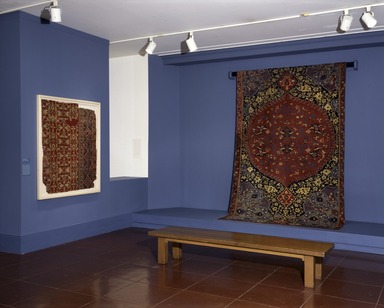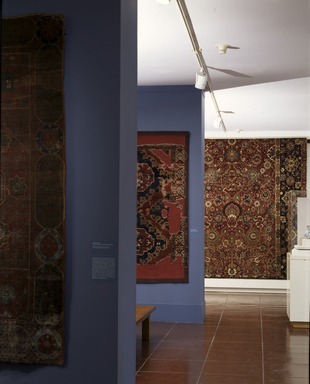
Magic Carpets: Selections from the Brooklyn Museum Collection (long-term installation)
DATES November 06, 1996 through September 23, 1998
ORGANIZING DEPARTMENT
Arts of the Islamic World
COLLECTIONS
Arts of the Islamic World
-
August 1, 1996
Magic Carpets: Selections from The Brooklyn Museum Collection, an installation of seven 16th- and 17th-century carpets from the Caucasus, Egypt, Iran, Spain, and Turkey, will be presented at The Brooklyn Museum from November 6, 1996, through fall 1998. Organized by Layla Diba, Associate Curator of Asian Art at The Brooklyn Museum, the installation comprises four carpets from the permanent collection and three carpets on loan from the Marshall and Marilyn R. Wolf Collection.
Magic Carpets will be the first installation of the Museum’s carpets since the 1985 exhibition of oriental carpets from the bequest of Mrs. Joseph V. McMullan. The installation features important carpets, many of which have never been on public view, donated by members of the Pratt family, renowned collectors of Brooklyn origin, and the eminent Islamic art collector Ernest Erickson. It is presented in conjunction with Philadelphia’s International Conference of Oriental Carpets (October 31-November 4, 1996).
During the reign of the Mamluk sultans in Egypt, popular carpet styles featured geometric patterns and a rich red, green, and light blue palette, producing a kaleidoscopic effect. The Museum’s wool pile Mamluk rug, woven in Cairo during the early 16th century, is an exceptional example of the single star type, featuring a central medallion that extends outward into an octagon formed by smaller star shapes.
Ottoman carpet design relied on the repetition of star-shaped and polygonal units until the 16th century, when innovative compositions featuring large center medallions based on Persian prototypes were introduced in the Ottoman manufactories. The Museum’s magnificent mid-16th-century Ottoman Medallion Ushak carpet is related to an example in the Thyssen-Bornemisza collection. The carpet’s red medallion alternates with four star-shaped half-medallions in light blue on an indigo blue ground. Though the carpet’s scale is impressive at more than 13 feet in length, it has been cut down from a multiple medallion carpet.
Other rugs from the Museum’s collection included in the installation are a 17th-century Dragon Carpet from the Caucasus, featuring a powerful pattern of palmettes, lancet leaves, and stylized dragons, and a rare late 15th-century Hispano-Moresque rug with pomegranate-shaped palmettes. Carpets on loan from Marshall and Marilyn R. Wolf, among the foremost collectors of Turkish and Oriental rugs, admirably complement the Museum’s display of carpets from the classical period. Their loans include a large pattern village Holbein fragment in wine red tones and a Lotto fragment, both woven in Turkey during the 16th century. In addition, there will be a magnificent Indo-Persian carpet formerly in the Wildenstein and Ojjeh collections that is approximately 24 feet in length and dates from the late 16th or early 17th century. Supplementing the installation is a selection of 9th- or 10th-century Egyptian embroidered and tapestry-woven textile fragments and silk embroidery from Persia and the Caucasus that date from the 17th and 18th centuries.
Brooklyn Museum Archives. Records of the Department of Public Information. Press releases, 1995 - 2003. 07-12/1996, 109-110.
View Original
